The 30-Minute Full-Body Dumbbell Workout
Adding dumbbell weights to your workout routine is an excellent way to boost the amount of calories you burn, increase your muscle tone, promote bone density, and ramp up your metabolism.
Even if you don’t want to bulk up, everyone should aim to increase the density of their muscle mass. The benefits include:
burning more calories at rest (even when you’re not exercising)
more efficient blood flow
increasing support for joints
the ability to perform more challenging body movements
increased stamina and energy
for women, less painful menstrual cycles
combating the natural muscle diminishing that happens with age
managing chronic conditions like back pain, diabetes, obesity, and heart disease
sharpening your mental focus and clarity
preventing osteoporosis, since stressing your bones leads to an increase in bone density
Equipment needed
Two dumbbells are required for all of these exercises. If you are a weight-training novice, start with 10-pound dumbbells and work up, as you feel comfortable. A yoga mat is optional for added comfort and back support.
Strength training is vital to overall health and fitness for everyone, regardless of age. Don’t have access to a gym? No problem. All you need is a few dumbbells at home in order to get an effective, full-body workout.
Equipment needed
Two dumbbells are required for all of these exercises. If you are a weight-training novice, start with 10-pound dumbbells and work up, as you feel comfortable. A yoga mat is optional for added comfort and back support.
Lunge and bent row
This hybrid move primarily tones your glutes and hamstrings, along with your upper back.
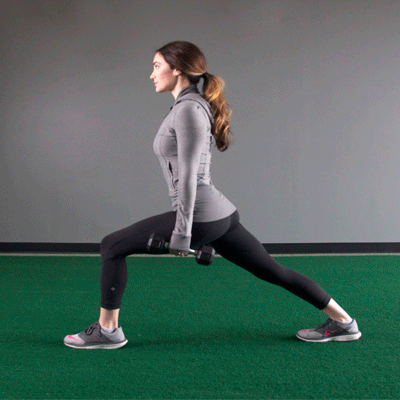
Start upright with a dumbbell in each hand and feet shoulder-width apart.
With your left leg, take a large step forward and drop your bottom down so that your leg forms a 90-degree angle.
While holding this position, lean your torso forward and then perform a row by clenching your back muscles, pulling your should blades together, and moving your upper arms and elbows toward the ceiling.
Repeat the same movement with your right leg and concentrate on driving your weight down through your heels as you come out of the lunge.
Focus on keeping your chest out and your shoulders back throughout the row motion.
Perform 20 repetitions (1 lunge + 1 row = 1 repetition).
Squat and shoulder press
The squat coupled with a shoulder press primarily strengthens your quads, hamstrings, glutes, and shoulders.
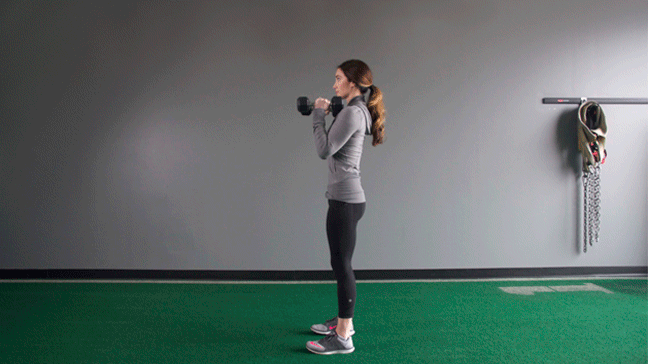
Stand up with your feet shoulder-width apart and a dumbbell in each hand.
Drop your bottom down into a squat, so that both legs are at a 90-degree angle.
Push your weight down through your heels to propel your body upward.
Make sure to keep your knees in line with your feet and don’t let them cave inward. Don’t let your toes go past the forward bend of the knees.
As you come up from your squat, press both dumbbells overhead, straightening your elbows at the top.
Focus on keeping your chest up, core tight, and hips forward throughout the squat motion.
Move into the next rep immediately after you perform the shoulder press.
Perform 20 repetitions (1 squat + 1 press = 1 repetition).
Sumo squat and upright row
This dynamic move targets the outside of your thighs, upper back and posterior aspect of your shoulders.
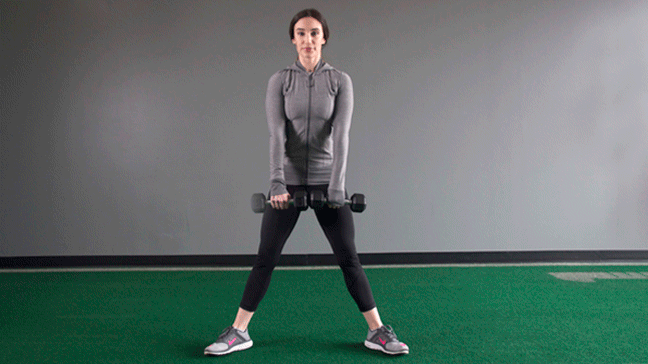
Begin upright with your feet placed wider than shoulder-width apart, with your toes pointing outward at a 45-degree angle.
Let your arms dangle between your legs, with your dumbbells in hand.
Drop your bottom down and perform a squat, keeping your feet turned outward.
Focus on keeping your knees pressed outward as you come out of the squat. This isolates the outside of your thighs and prevents knee pain.
As you come up, pull the dumbbells upward to chest level with elbows out, and at about shoulder level.
Make sure to keep your torso upright, not bent over.
Perform 20 repetitions (1 sumo squats + 1 upright row = 1 repetition).
Dumbbell situps
Dumbbell situps are a great way to ramp up this traditional abdominal move.
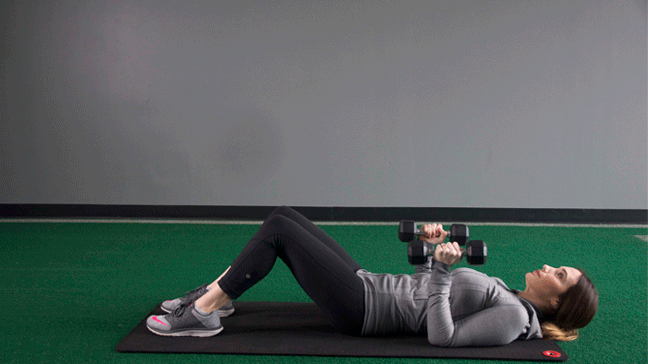
Start by lying flat on your back, feet flat on the ground, knees bent, holding the dumbbells in each hand next to your chest.
Sit up, bring your torso upright, and push the dumbbells overhead, as one combined movement.
Resist the urge to let momentum bring your body off of the ground.
Control your body as you come back down by clenching your abdominal muscles and keeping them engaged.
Perform 20 repetitions.
Glute bridge and chest press
This hybrid move tones your glutes, chest, and shoulders.
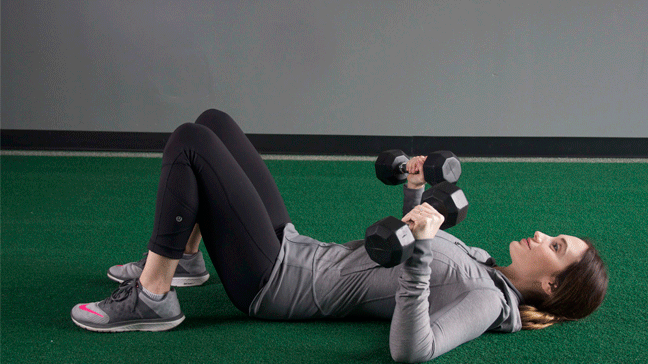
Begin lying flat on your back with your legs bent, feet flat on the ground, holding one dumbbell in each hand right, next to your chest.
Drive your weight down through your heels and elevate your hips so that they’re in line with your shoulders and knees.
At the same time, push the dumbbells upward directly above your chest.
Bring your hips and dumbbells back down to the ground simultaneously.
You can isolate your quads more by driving your weight down through your toes.
Perform 20 repetitions (1 glute bridge + 1 chest press = 1 repetition).
30-minute AMRAP
The structure of an AMRAP workout is simple. Perform “as many reps as possible” (AMRAP) within a given time period.
This way of exercising can be highly motivating, as you are racing against the clock. The idea of “ready, set, go!” with the clock ticking will put you into race mode and get your heart rate going immediately.
To perform a 30-minute AMRAP with the moves you just learned, follow this guide.
Complete:
20 lunges with a bent over row (1 lunge + 1 row = 1 repetition)
20 squats with a shoulder press (1 squat + 1 press = 1 repetition)
20 sumo squats with an upright row (1 sumo squat + 1 row = 1 repetition)
20 dumbbell situps
20 glute bridges with a chest press (1 glute bridge + 1 chest press = 1 repetition)
Rest for 2 minutes.
Work through this sequence as many times as you can within a 30-minute window.
The takeaway
This dumbbell workout should typically be done about three days a week. The off days give your body time to rebuild, recover, rest, and replenish itself so that your muscles can adapt to the new demands you’re placing on them.
As you get stronger and more comfortable with these movements, look to increase your dumbbell weight.
Support of Agency
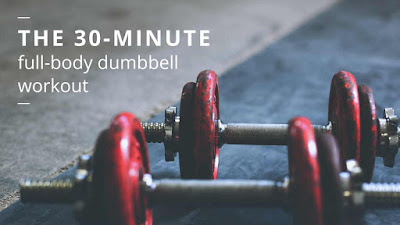

Comments